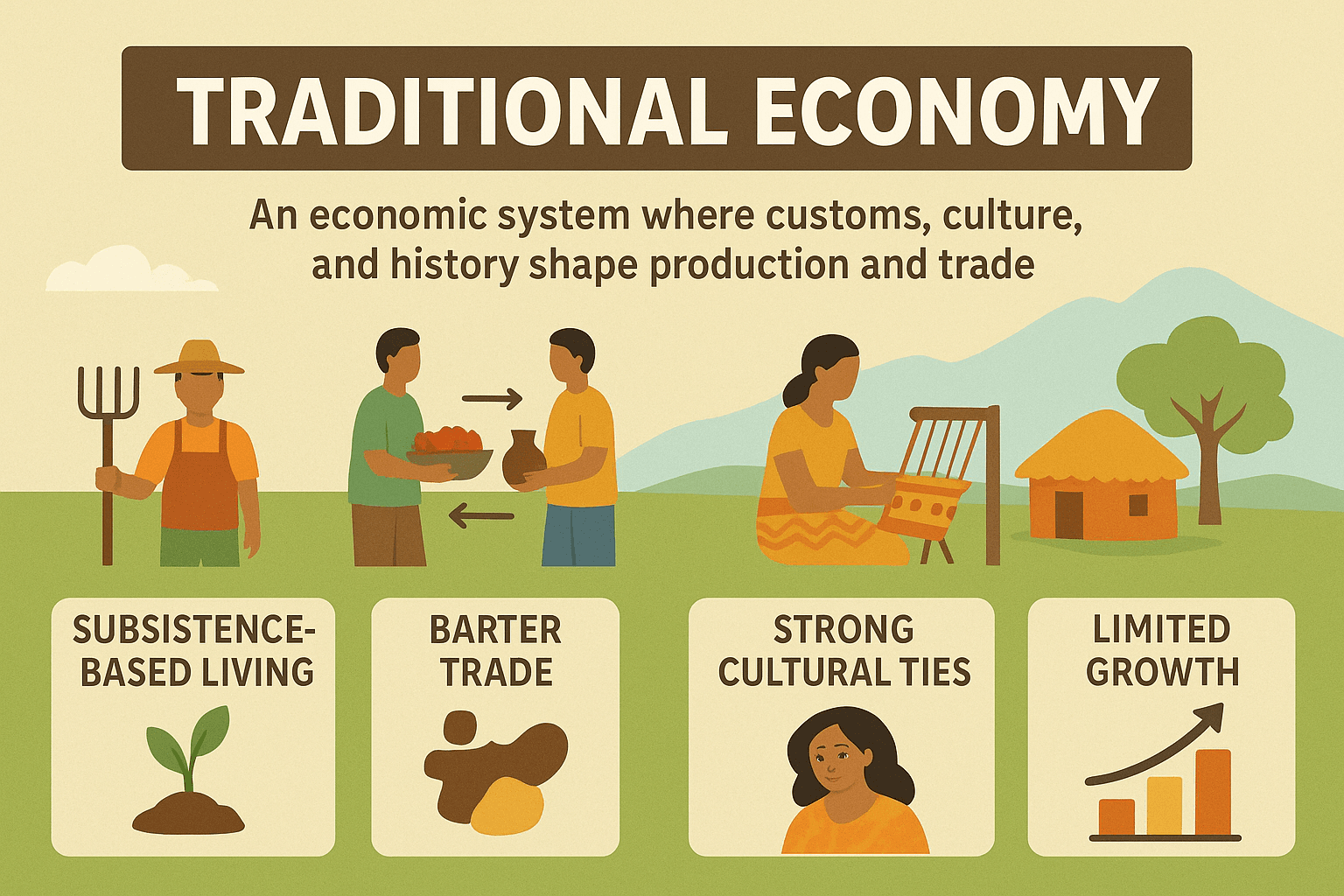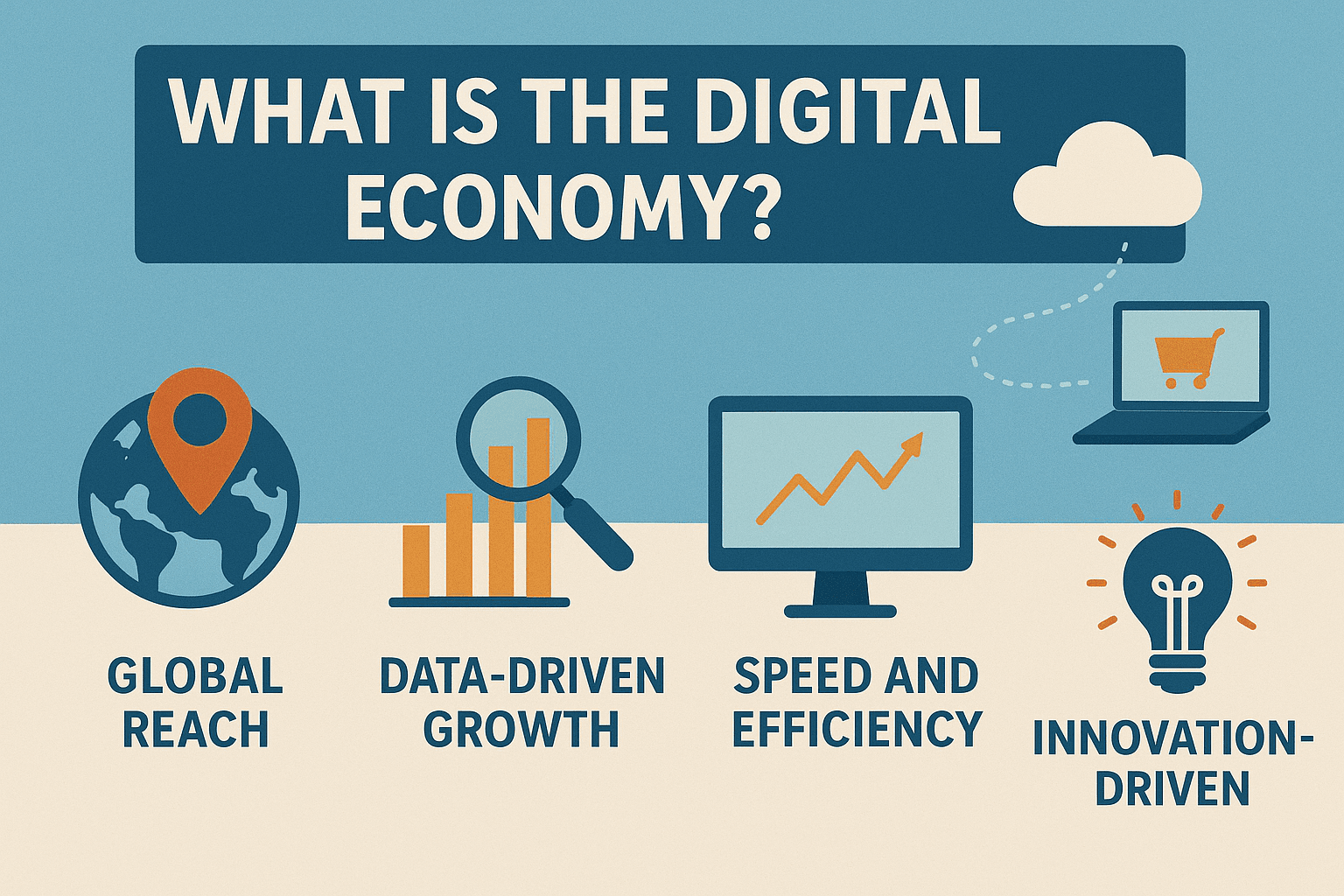business resources
Traditional Economy vs Digital Economy: What Every Business Leader Must Know
16 Sept 2025, 11:08 am GMT+1
The digital economy now accounts for over 15% of global GDP, yet millions still rely on the Traditional Economy for survival. From global e-commerce to AI-driven growth, opportunities are huge, but can businesses truly balance speed, innovation, and tradition to thrive in this rapidly changing world?
The world of business is moving faster than ever before. According to the World Bank, digital trade already contributes to more than 15% of global GDP, and this share is expected to grow to nearly 25% by 2030.
On the other hand, millions of people across the globe still depend on farming, local crafts, and barter-based exchanges that belong to the Traditional Economy. This creates an interesting contrast: while one system is data-driven and global, the other is deeply tied to culture, community, and survival.
For business leaders, this isn’t just an academic debate. It is about understanding where value is created, how markets evolve, and what lessons can be carried forward. For instance, a McKinsey report shows that companies embracing digital transformation see 45% faster revenue growth compared to their peers. But at the same time, research on consumer behaviour shows that 71% of customers value authenticity and heritage in brands, something rooted in the principles of the Traditional Economy.
What is the traditional economy?
The Traditional Economy refers to an economic system where customs, culture, and history shape production and trade. It is rooted in agriculture, farming, fishing, craft-making, and barter trade. Communities in such economies produce what they need for survival, often using simple methods passed down across generations.

Some key features of the Traditional Economy include:
- Subsistence-based living – families and small communities produce only what they need.
- Barter trade – goods and services are exchanged directly without money.
- Strong cultural ties – customs and traditions guide production methods.
- Limited growth – innovation is slow because knowledge is shared within the community.
While this system seems outdated, it shaped the foundation of modern economies. Even today, parts of the world continue to operate under the Traditional Economy, especially in rural or indigenous areas.
What is the digital economy?
The digital economy is built on digital technologies, networks, and data. Unlike the Traditional Economy, it is borderless, fast, and highly scalable. Businesses operate online, sell globally, and rely on tools such as artificial intelligence, cloud computing, and digital payments.

Some key features of the digital economy include:
- Global reach – a small start-up can reach millions of customers worldwide.
- Data-driven growth – businesses collect and analyse consumer data to personalise services.
- Speed and efficiency – transactions happen instantly, often with little human involvement.
- Innovation-driven – rapid advancements in technology lead to new products and services.
Statistics that show its impact:
- The digital economy is worth over $20 trillion, according to UNCTAD.
- Global e-commerce sales surpassed $6.3 trillion in 2024, with forecasts to reach $8.1 trillion by 2027 (Statista).
- By 2030, 90% of global jobs will require digital skills, according to the World Economic Forum.
The scale and influence of the digital economy are undeniable. For business leaders, it means that adapting to technology is no longer optional; it is essential.
Traditional economy vs digital economy
While both systems aim to create value, the way they function is completely different. Let us break down the major differences:
Aspect | Traditional Economy | Digital Economy |
| Production | Based on agriculture, crafts, and local skills | Driven by technology, software, and automation |
| Trade | Local barter or physical exchange | Global online marketplaces |
| Growth | Slow, steady, based on natural resources | Rapid, scalable, driven by data and innovation |
| Money | Often absent, or limited use | Digital-first: credit cards, online payments, cryptocurrencies |
| Innovation | Minimal, knowledge passed down | Constant, rapid |
Lessons from the Traditional Economy
Even though the digital economy dominates today, the Traditional Economy still has important lessons for business leaders:
The power of community- In traditional systems, survival depended on cooperation. Trust, loyalty, and long-term relationships were more valuable than quick profits. Modern businesses can learn from this by focusing on authentic customer engagement. Research by Edelman shows that 81% of consumers need to trust a brand before buying from it.
Sustainability and balance- Traditional systems used local resources carefully, ensuring they lasted for generations. In contrast, the digital economy risks overconsumption of energy and raw materials. A focus on sustainability can make digital businesses more responsible and resilient.
Quality and craftsmanship- Every product in the Traditional Economy was made with skill and care. Today’s businesses can take inspiration from this craftsmanship to stand out in a crowded digital market. Luxury brands often succeed because they combine modern reach with traditional quality.
Patience and stability- Unlike the high-speed digital world, traditional systems evolved slowly. This stability created long-term security. Business leaders can learn that not all growth has to be rushed; sometimes, sustainable growth is better.
The rise of hybrid models
The most successful economies today are not purely digital or purely traditional—they are hybrids. Businesses and governments are finding ways to merge the strengths of both.
- Retail – Local shops in villages now list products on Amazon or Flipkart while still selling in their communities.
- Banking – Traditional banking exists alongside fintech apps, offering both trust and convenience.
- Agriculture – Farmers use drones and AI tools to monitor crops while sticking to traditional methods of cultivation.
- Tourism – Cultural tourism thrives when traditional heritage is marketed globally using digital platforms.
This blending shows that the Traditional Economy is not irrelevant—it has simply found a new role in the digital age.
Challenges business leaders face
Transitioning between the two systems is not easy. Leaders face unique challenges such as:
- Technology Gaps – Small businesses rooted in the Traditional Economy often lack access to advanced digital tools.
- Cultural Resistance – Employees and communities may resist adopting new systems.
- Cybersecurity Risks – Digital growth invites online fraud and data breaches. Cybercrime damages the global economy by $8 trillion annually (Cybersecurity Ventures).
- Intense Competition – The digital world brings global rivals into local markets.
Leaders must recognise these challenges and build strategies to address them.
Opportunities in the digital economy
While challenges exist, the opportunities are far greater. Some of the biggest benefits for businesses include:
1. Wider Market Access
In the past, businesses could only sell to their local communities or nearby regions. Today, even the smallest company can reach a global audience with minimal investment.
For example, a handmade craft seller in Jaipur can sell to buyers in London or New York through platforms like Etsy or Amazon. According to Statista, over 2.6 billion people worldwide now shop online, and this number continues to rise every year. This global reach means businesses are no longer restricted by geography.
2. Cost Efficiency
Running a business in the Traditional Economy often required large investments in land, factories, or physical shops. In the digital world, many of these costs are reduced.
Cloud computing eliminates the need for expensive servers, while automation tools handle repetitive tasks such as invoicing, customer support, and marketing campaigns. Research from Deloitte shows that businesses using automation cut operational costs by up to 30%, freeing resources for innovation and growth.
3. Personalisation at Scale
In traditional markets, personalisation depended on direct relationships between shopkeepers and customers. The digital economy allows the same personal touch but on a massive scale. Using data analytics, companies can understand customer preferences and deliver tailored recommendations.
For instance, Netflix uses algorithms to suggest films based on viewing history, while e-commerce giants personalise shopping experiences to increase satisfaction and sales. Studies show that 80% of customers are more likely to buy from brands offering personalised experiences.
4. Scalability and Speed
One of the biggest advantages of the digital economy is scalability. Businesses can expand operations quickly without building new factories or offices. A software company, for example, can serve millions of users simply by upgrading servers, something that was impossible in the Traditional Economy.
This scalability also means businesses can test ideas faster, pivot when needed, and grow without heavy infrastructure costs.
5. Innovation-Driven Growth
The digital economy thrives on constant innovation. Whether it is AI-powered customer service, blockchain-based supply chains, or augmented reality in retail, businesses can adopt cutting-edge tools to stay competitive. This innovation cycle creates opportunities for both start-ups and established firms to disrupt industries and capture new markets.
6. Flexibility and Remote Work
Unlike the rigid structure of the Traditional Economy, digital tools enable flexibility in how businesses operate. Remote work, freelancing platforms, and global talent pools allow companies to hire the best talent regardless of location. A report from Gartner found that 74% of companies plan to shift permanently to more remote work after realising the productivity and cost benefits.
7. Better Customer Engagement
Digital platforms allow constant interaction with customers. Social media, email campaigns, and chatbots ensure businesses can connect instantly with their audience. Unlike the one-way communication in traditional systems, today’s businesses can create two-way conversations that build stronger loyalty.
Read More:
Is the Traditional Economy Still Relevant in 2025?
Why every business leader must understand both
Ignoring the Traditional Economy means ignoring the roots of trust, relationships, and cultural values. Ignoring the digital economy means missing out on growth, efficiency, and innovation. The real success lies in combining both perspectives.
For example, a brand selling handmade crafts can use digital platforms to reach international customers while still maintaining traditional production methods. A farming business can use digital tools for crop monitoring but stay rooted in sustainable, traditional practices.
By respecting the past and embracing the future, leaders can create businesses that are strong, flexible, and future-ready.
Conclusion
The Traditional Economy was built on relationships, survival, and trust. The digital economy is built on data, speed, and innovation. For today’s leaders, the challenge is not choosing one over the other but finding the balance.
By learning from the values of the Traditional Economy and blending them with digital-first strategies, businesses can achieve sustainable growth, global reach, and long-lasting customer loyalty.
The future is not about abandoning tradition; it is about evolving it for the digital age.
Share this
Shikha Negi
Content Contributor
Shikha Negi is a Content Writer at ztudium with expertise in writing and proofreading content. Having created more than 500 articles encompassing a diverse range of educational topics, from breaking news to in-depth analysis and long-form content, Shikha has a deep understanding of emerging trends in business, technology (including AI, blockchain, and the metaverse), and societal shifts, As the author at Sarvgyan News, Shikha has demonstrated expertise in crafting engaging and informative content tailored for various audiences, including students, educators, and professionals.
previous
Is the Traditional Economy Still Relevant in 2025?
next
How Dropshipping Can Save Money Without Sacrificing Quality for Your Art Shop